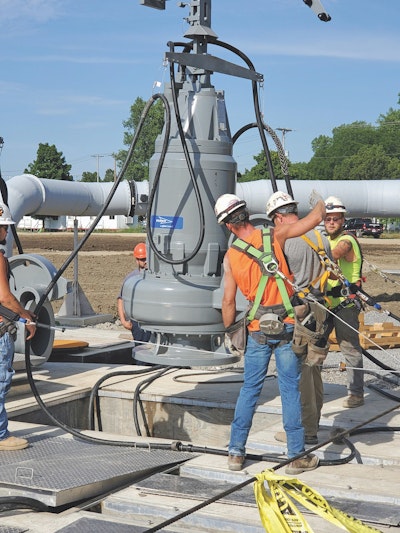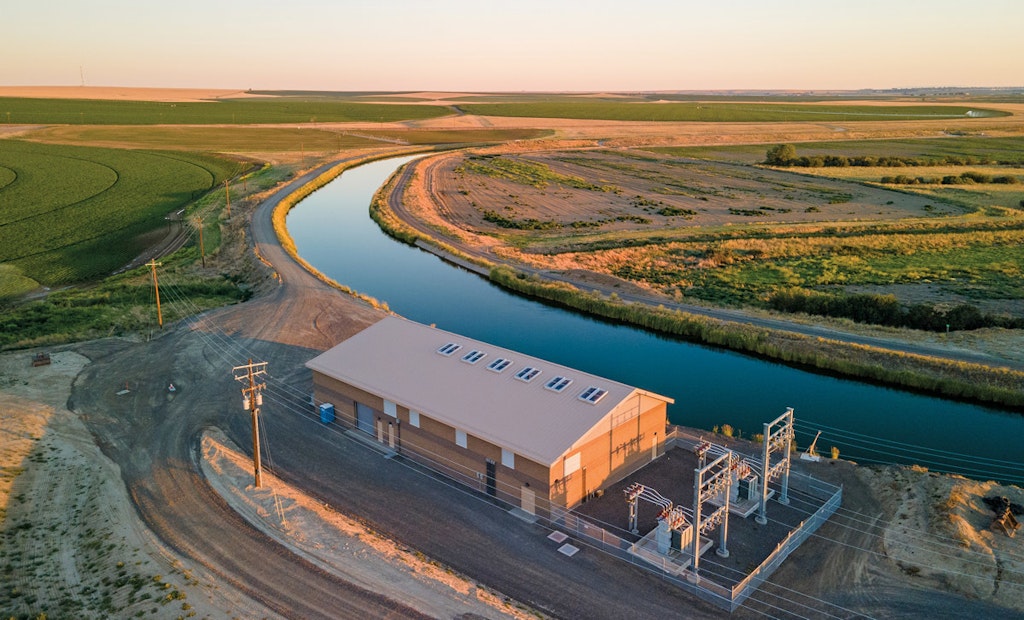Interested in Infrastructure?
Get Infrastructure articles, news and videos right in your inbox! Sign up now.
Infrastructure + Get AlertsDwindling water supplies are posing a serious threat to farmers and communities across the American West. Securing water is one challenge. Delivering it is another.
The Odessa Aquifer in Washington has been rapidly declining since 1980, falling more than 200 feet as farmers, municipalities and homeowners drilled deeper wells to reach the diminishing water supply. The U.S. Bureau of Reclamation says more than 700 irrigation wells were drilled in the region, with some wells reaching down nearly 2,000 feet.
A new project will offer much needed relief for users of the Odessa Aquifer. A pumping station that will provide water for up to 10,500 acres in the region became operational earlier this year. The project started in 2016 and was redesigned in 2017-18 due to a grant to allow for additional capacity. Construction was completed in late summer 2020.
The Odessa Ground Water Replacement Project, at an estimated cost of approximately $400 million, will eventually include a minimum of nine systems and have a profound economic and environmental impact, according to Vicky Scharlau, executive director of the Columbia Basin Development League.
“It’s nearly 200,000 people and over a dozen, maybe two dozen small communities that really represent the fiber and the structure of the Columbia Basin and agriculture and farm communities as we know them,” she says.
How it works
The first Odessa pump distribution system, called EL47.5, includes nearly 9 miles of pipe, six pumps and a pump house. The water system, at a construction cost of $20.8 million, is named for its distance from the start of the East Low Canal. It is the first of nine proposed pressurized pipeline systems being built to deliver Columbia Basin Project surface supplies to replace groundwater use on 87,000 acres across Grant, Adams and Lincoln counties.
“Water is ordered daily, conveyed through the East Low Canal and delivered on a 24-hour basis,” Scharlau says. “The water is sent down the canals and the pumping station is just one of many outlets that takes water from the canal and distributes it to the different lands.”
The EL47.5 system is just one cog in the Odessa Ground Water Replacement Program. The systems are part of the larger Columbia Basin Project, which currently serves approximately 680,000 acres.
The scope of work for the Odessa Ground Water project is far-reaching. Workers widened 46 miles of the East Low Canal, constructed seven siphons, and will add seven radial gates and replace 12 bridges.
“Lands are all upslope from the East Low Canal, so pumping is a necessity,” Scharlau says. “Open channel flow deliveries were financially prohibitive and would’ve required a new canal system to be built. Besides regulatory hurdles, costs were estimated in the billions. For this situation, the pump distribution system was the best option for water delivery to farmers.”
EL47.5 is the first pumping station in the wide-reaching Odessa groundwater system, and teams faced a series of challenges that hopefully will be reduced in subsequent stations.
“Regulations, costs and easement issues were overcome by time and perseverance,” Scharlau says. “Once it was designed, construction was pretty smooth. The pandemic occurred during construction of the plant, and that certainly didn’t help.”
Heart of the system
At the heart of the EL 47.5 project is the 12,800-square-foot pump station, which will reduce groundwater depletion by up to 73 million gallons per day.
The station includes one 700 hp pump and five 1,250 hp pumps. The powerful system can deliver more than 63,000 gpm. The station has a delivery capacity of 10,500 acres, pumping water at 140 cubic feet per second at 345 feet total dynamic head. The pumps pull water out of the canal, and it’s delivered based on daily orders of irrigators who bought water on long-term contracts.
The intake structure includes a sump that is 35 to 86 feet wide, 80 feet long and 18 feet deep. It includes 820 cubic yards of concrete and 145,000 pounds of rebar. The pumps deliver water through 8.88 miles of pipelines that are 14 to 60 inches in diameter with 15 turnouts.
“This is the first pumping plant in the project and the land that it serves is what makes this pump station unique,” says Jon Erickson of the East Columbia Basin Irrigation District and project manager of the Odessa Ground Water Replacement Project. “This is an important step in getting water to the farmers who need it.”
The ECBID designed the pumping station, which was built by Goodman & Mehlenbacher Enterprises.
Accessing pumps
The pumps are an important part of the project, but installing and accessing the pumps when they eventually need maintenance or replacement was one of the important design considerations in the station’s construction.
Teams will access the pumps through six roof hatches manufactured by The BILCO Co. The custom hatches, which are 6 feet, 6 inches by 70 feet, are fabricated with polycarbonate dome cover covers for natural daylight and engineered lift assistance for easy, one-hand operation. They are also modified for hand-winch operation, allowing them to be easily opened and closed from inside the building.
The aluminum hatches, which were supplied by Anderson Specialties, were custom-fabricated to meet unique size requirements. “They were proposed by the contractor and met the specs that we required,” Erickson says. “They were also important because they allowed pump and motor access by crane.”
Critical industry
As an important economic driver in the region, water from the project will be critical to farmers, families and businesses. While farmers could have continued to draw water from the aquifer, it may have eventually gone dry. That’s not a chance regional stakeholders were willing to take.
“It is only speculative when and what would have happened without the project,” Scharlau says. “However, trends have shown a consistently declining aquifer.”
The project will allow farmers to continue working the land with less impact on the local aquifer, to the benefit of the region’s overall economic health.








